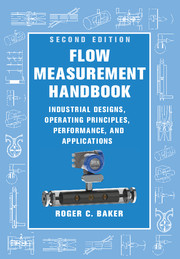Book contents
- Frontmatter
- Dedication
- Contents
- Preface
- Acknowledgements
- Nomenclature
- 1 Introduction
- 2 Fluid Mechanics Essentials
- 3 Specification, Selection and Audit
- 4 Calibration
- 5 Orifice Plate Meters
- 6 Venturi Meter and Standard Nozzles
- 7 Critical Flow Venturi Nozzle
- 8 Other Momentum-Sensing Meters
- 9 Positive Displacement Flowmeters
- 10 Turbine and Related Flowmeters
- 11 Vortex Shedding, Swirl and Fluidic Flowmeters
- 12 Electromagnetic Flowmeters
- 13 Magnetic Resonance Flowmeters
- 14 Ultrasonic Flowmeters
- 15 Acoustic and Sonar Flowmeters
- 16 Mass Flow Measurement Using Multiple Sensors for Single-Phase Flows
- 17 Multiphase Flowmeters 508
- 18 Thermal Flowmeters
- 19 Angular Momentum Devices
- 20 Coriolis Flowmeters
- 21 Probes for Local Velocity Measurement in Liquids and Gases
- 22 Verification and In Situ Methods for Checking Calibration
- 23 Remote Data Access Systems
- 24 Final Considerations
- References
- Main Index
- Flowmeter Index
- Flowmeter Application Index
12 - Electromagnetic Flowmeters
Published online by Cambridge University Press: 05 August 2016
- Frontmatter
- Dedication
- Contents
- Preface
- Acknowledgements
- Nomenclature
- 1 Introduction
- 2 Fluid Mechanics Essentials
- 3 Specification, Selection and Audit
- 4 Calibration
- 5 Orifice Plate Meters
- 6 Venturi Meter and Standard Nozzles
- 7 Critical Flow Venturi Nozzle
- 8 Other Momentum-Sensing Meters
- 9 Positive Displacement Flowmeters
- 10 Turbine and Related Flowmeters
- 11 Vortex Shedding, Swirl and Fluidic Flowmeters
- 12 Electromagnetic Flowmeters
- 13 Magnetic Resonance Flowmeters
- 14 Ultrasonic Flowmeters
- 15 Acoustic and Sonar Flowmeters
- 16 Mass Flow Measurement Using Multiple Sensors for Single-Phase Flows
- 17 Multiphase Flowmeters 508
- 18 Thermal Flowmeters
- 19 Angular Momentum Devices
- 20 Coriolis Flowmeters
- 21 Probes for Local Velocity Measurement in Liquids and Gases
- 22 Verification and In Situ Methods for Checking Calibration
- 23 Remote Data Access Systems
- 24 Final Considerations
- References
- Main Index
- Flowmeter Index
- Flowmeter Application Index
Summary
Introduction
The possibility of inducing voltages in liquids moving through magnetic fields was known by Faraday in 1832, but the first flowmeter-like device was reported by Williams in 1930. The first real advance in the subject came from the medical field where Kolin (1936, 1941) introduced many ideas which are now standard practice. In 1941 Thürlemann gave the first general proof, essentially of Equation (12.2) as set out later in this chapter (see also Thürlemann (1955) and Shercliff (1962) for more background).
The industrial interest arose in the 1950s with:
• the Tobiflux meter (Tobi 1953) in Holland for rayon viscose, sand-and-water and acid slurries;
• Foxboro, to whom the patent was assigned in 1952;
• the first commercial instruments in 1954 (Balls and Brown 1959).
• nuclear reactor applications;
• the work which resulted in an essential book by J. A. Shercliff (1962).
In this chapter we shall concentrate on the application of the flowmeter to fluids that are of low conductivity, such as water-based liquids (Baker 1982; see also 1985). The flowmeter has also been proposed for use with non-conducting dielectric liquids and some designs have been built for this purpose. This is briefly discussed in the appendix section 12.A.9. It has also been used with liquid metals and this is briefly discussed in the appendix section 12.A.10.
Operating Principle
We start with the simple induction, which occurs when a conductor moves through a magnetic field. Figure 12.1 shows a copper wire cutting the flux of a permanent magnet. The wire is moving in a direction perpendicular to its length and perpendicular to the magnetic field with velocity V, and the result is a voltage generated between its ends of value BlV where l is its length and B is the magnetic flux density.
Figure 12.2 shows a diagram with the essential features of an electromagnetic flowmeter. The liquid flows in a circular cross-sectional tube. A magnetic field is created across the pipe, usually by coils excited by an alternating current. The tube itself must be made from nonmagnetic material so that the magnetic field can penetrate the tube.
- Type
- Chapter
- Information
- Flow Measurement HandbookIndustrial Designs, Operating Principles, Performance, and Applications, pp. 362 - 407Publisher: Cambridge University PressPrint publication year: 2016



